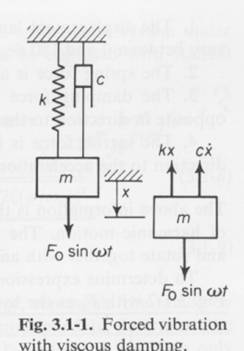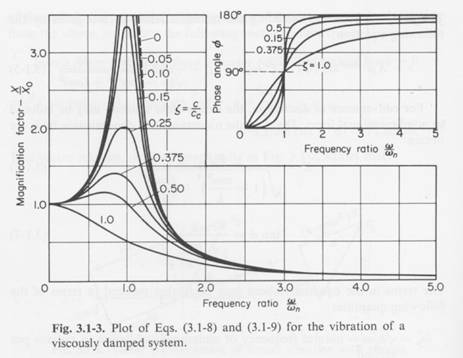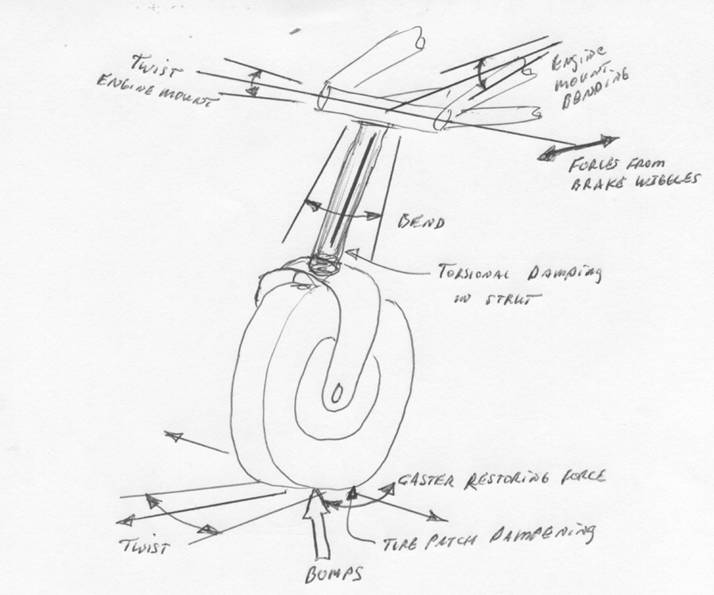I was pondering the ES nose wheel shimmy issue while
walking the dog, and it occurs that we have enough information and smarts in
the LML community to put this one to bed. It is just to persistent not to
warrant a full court press.
Disclosure: I am finishing a Lancair IV, and so can
comment only as an “outsider.”
Below I offer some basic insight into vibration,
speculate on causes, and offer some suggestions, but they are all based on the anecdotal
reports of LML, some work in shock/vibration many years ago, and a course in
vibration theory in engineering school during the Paleocene. With that in
mind….
Some Basics
Shimmy is vibration, and shimmy suggests vibration at
or near the natural frequency (resonance) of an oscillator which is somehow
excited to do its thing: oscillate at its preferred frequency.
Mechanical oscillators usually trade energy between a
spring (anything that can store energy as a function of deflection) and the
kinetic energy of motion in which the spring energy is traded for moving a mass.
You need a spring to store energy (it can be a beam, strut, engine mount or some
other bendable structure), a mass to wiggle, and an excitation force to start
the wiggle. When the frequency of the exciting force equals the natural
frequency then – bingo! - you have resonance and lots of big wiggles –
IF the oscillator is not adequately dampened by friction.
The excitation force can come from within the mass (a
vibrating engine), from the outside world applied to the mass (a gust bending
your wing) or from through the spring from the “base” moving up and
down such as a speed bump thumping your car through the suspension. The
responses are all roughly the same for purposes of this discussion – when
excitation force equals natural frequency, you get resonance - so we will
use the simplest model.
An example is shown below, copied from my old theory
of vibrations text book.

Here we have a base anchor point (top), a spring and a mass with a damper
in parallel with the spring. The weight wiggles up and down, and in this example
the excitation force is applied to the weight. The spring can be a torsion
spring and the weight can rotate back and forth, but the behaviour is essentially
the same.
Here is how movement of the weight responds to the excitation force as you
vary its frequency. Ignore the top right chart which shows phase angle, and
focus on the larger chart showing the magnification factor. Frequency is on
the bottom axis and the magnification factor of the weight movement is shown on
the vertical axis. The different curves show different levels of dampening.
Omega sub n is the natural frequency of the system. It is defined by the
stiffness of the spring and value of the mass.

First message: the greater the dampening, the lower
the magnification factor. When the excitation frequency is right on
the natural frequency, we call it resonance. If the dampening is low and
resonance occurs for a very long period (which can be millions of cycles for a
crankshaft or less than a second for wing flutter) the structure can
fail.
So dampening is good for minimizing vibration at
resonance.
Staying away from the natural frequency is good, but
for us, not possible. Since we are landing at (say) 80 knots and slowing
to zero, the excitation frequency, if it comes from tires, covers a broad range
down to zero. It is hard to change the natural frequency (goes as the
square root of spring constant over mass) so it is better to zip through the
natural frequency quickly to prevent the vibrations from building up.
Complications
The key factors are the mass, the stiffness of the
spring, the amount of dampening, and the frequency and amplitude of the exciting
force. The complication arises in from the fact that we do not have a
simple spring mass system. Rather we have somewhat flexible strut mounted
on a less flexible engine mount which is mounted on a big mass (the airframe)
which is not really a fixed base like the foundation of a building, and can be
wiggled as well. Also, the excitation can come from multiple sources from
outside the wheel/strut assembly (main gear brake wiggles which push the nose
wheel from side to side) or from within the wheel/strut (nose wheel imbalance
and from the self-centering forces arising from the caster angle of the strut).
More complication: the self-centering force arising
from the caster angle is like a spring. It applies a restoring force that
tries to push the nose gear to an equilibrium position. The restoring
force from the caster angle can be BOTH like a spring (restoring force gets
larger as the wheel turns more) and an excitation force since the tire
interacts with the ground and can collect energy from the ground/tire forces
when things start to wiggle. And the tire patch also offers some
dampening. The picture below gives an inkling of the complications.
(Please forgive my artwork.)

Clearly we have lots of springs, forces, and masses
(including torsion springs and masses) in the system. Add the fact that
portions of the airframe like to wiggle, and it gets even more difficult to
analyze. But understanding the simple model is enough to help diagnose
the problem. Excitation forces, springs, masses, and dampening are the
keys. Let’s review each in turn.
Springs and Masses
Not much we can do here. Basically we would
like to adjust the natural frequency of the strut assembly to be so high (or so
low) that real world excitation forces will not cause resonance to begin.
Fuggedaboutit. You can not change the spring stiffness or masses enough
to make a difference.
With three exceptions: ES aircraft have a nose wheel
pant which increases the torsional moment of inertia which reduces the
rotational natural frequency of the nose gear compared to no nose pant. Moving
the frequency down lower may make the torsional natural frequency come closer
to the strut bending natural frequency. If they lay on top of one
another, you are more likely to get trouble. But I speculate, and the
reports suggest other causes are more likely.
The second exception is the length of the
strut. Extended, it is more flexible (lower natural frequency) than when
retracted. On my 182 RG the rare nose wheel shimmy could be stopped by
pushing the stick and shortening the strut. That raises the natural
frequency. Whether you want to raise or lower the natural frequency
depends on where it is, and how fast you are going. The reverse may be
true on the ES. Any reports from pilots?
One possibility: the longer wing and larger tail
surface of the ES make the airframe moment of inertia about the vertical axis
larger than it will be on the IV. The ES is more resistant to being
rotated around the vertical axis. If the oscillator behavior is
sensitive to the rotational tendency of the airframe (the strut and the
airframe wiggle together and could create coupled oscillators), the longer wing
would lower the oscillator frequency a bit. But this seems like an
unlikely source compared to other possibilities. And besides, there
is nothing we can do about it except be aware of it.
The third exception is fuel load. Having more
fuel increases the moment of inertia and reduces the natural frequency of the
fuselage around its vertical axis. And sloshing fuel adds
dampening. But I think this is a long shot and besides we can do nothing
about it.
Excitation forces
We have lots to work with here. Get rid of
them. Not entirely possible, of course, so minimize them. What
could they be?
1)
Nose wheel imbalance or out of round or uneven nose tire wear are
obvious causes and should be examined. The excitation force will generally be
the rotational speed of the tire and that will start from about 2200 RPM (36
cycles per second) down to zero (14 inch OD tire, 80 knots touchdown
speed). Anecdotal reports suggest the problems usually occur in the 20-40
knot speed range (to be verified) suggesting frequencies of 9 to 18 cycles per
second. Those kinds of numbers feel intuitively correct.
2)
Main gear imbalance: same thing. Imagine if both tires are out of
balance and they get 180 degrees out of phase so that they alternate in pulling
forward and backward. The main gear imbalance can cause the nose to
wiggle from side to side, and if that forcing frequency is just right, you get
resonance.
3)
Main gear braking action can be a problem for the same reason as main
gear imbalance, although the forces can potentially be much larger and independent
of rotational speed. Imagine a brake disk that is of variable
thickness. You will get wiggles as you brake and they will get worse the
harder you press. Reports suggest that going to high energy brakes can
help. Brake fade has been reported on low energy brakes. Brake fade comes
from high temperatures which create a lot of gas emission from the brake pad
which lubricates the pad/disk interface. Essentially gas pressure holds
the pad off the disk. Changes in the surface texture on the disk can
cause variability as the disk rotates because the gas escape and friction can
vary. High energy brakes substitute materials that reduce gas emission
rates, pad designs that let the gas escape and rotors that can take higher
temperatures without bad behavior. ES brakes maybe more subject to brake
fade than the IV because the rotors and calipers are inside the wheel pant and
can not cool as well. If the low energy brake disks warp from the higher
level of heating it could well contribute to increasing any exciting forces
coming from the main gear. Add this to wheel/tire imbalance, get
everything in the right phase, and these forces could be large enough to cause
problems, and also cause the airplane nose to bob up and down a bit as well.
4)
Nose gear caster angle creates self centering restoring forces that can
be both spring forces for an oscillator, and exiting forces for that same
oscillator. The caster angle clearly has to have some effect, and I
suspect the tire pressure does as well since a wiggling nose tire is making S
turns down the runway. As the nose wheel makes its S turns, more caster
angle will result in larger vertical forces as the tire to rotates around the
strut central axis. If the strut is not vertical viewed from the
front, there will be a continuing side force trying to turn the nose wheel.
This force and forces opposing it (to keep the airplane straight) could yield
excitation forces.
5)
Bumps from rocks and bumps on the runway create a one time hit to the
oscillator, like ringing a bell. If the shape of the pulse created has a
lot of energy at the natural frequency of the system, it could excite the
oscillator which otherwise may have remained quiescent during the deceleration.
But I think it would take a long bump. If the natural frequency
corresponds to, say, 30 knots (50 feet per second), an oscillation of 10 cycles
per second means one cycle consumes 5 feet of travel distance. A half wavelength
bump would 2.5 feet. Such a bump would contain a lot of energy at 10
cycles per second. But 2.5 to 5 feet seems to suggest a single tire
rotation more than a bump. But things can add up.
Dampening
Here again we have something to work with.
1)
Strut oil is the obvious target. Anecdotal evidence suggests that
hot struts thin oil and reduce dampening to the point that shimmy can
occur. On the IV, the strut is baked under the engine during flight, but
cools somewhat during descent, and then is cooled a lot when the gear is
extended. Is 3-5 minutes enough time to bring the oil temperature in the hot
strut down close to ambient while you motor around the pattern? I think
so given the 100 knot cooling blast. So controlling strut heating by
preventing hot air flow down the strut fairing seems worthwhile. Higher
viscosity oil should help as well, but watch out in Minnesota in the winter.
2)
There is dampening in the nose tire patch that contacts the runway,
particularly if the nose wheel starts to make fast S turns. A bigger tire
patch from lower pressure would seem to help.
3)
There is also dampening in structure: strut, strut to engine mount
connection, engine mount dampening (probably very low for the stiff welded
structure) and perhaps even some effect from the elastic engine mounts as the nose
gear shimmies under the engine mass. But there is not much we can do
except to check that everything is tight.
Checklist
This discussion suggests a checklist that would
include the following:
1)
Tire balance, mains as well as nose wheel. And check that they are
round and not unevenly worn.
2)
Brake pulsations caused by warped or variable thickness disks that may
have been overheated. Substituting high energy brakes or maybe just a
resurfacing of the brake rotor could help.
3)
Keep the strut cooler by blocking hot airflow down the strut, or
increase the viscosity of the oil. Lancair IV drivers could put the gear
down earlier, particularly on a hot day, to provide for more strut cooling.
4)
Check the strut and engine mount structure for free play. Make
sure everything is tight
5)
Look for cracks on the engine mount. These can change the spring
rate and natural frequency which may worsen the tendency to shimmy.
6)
Adjust nose tire pressure, probably downward.
7)
Check strut to make sure it is vertical viewed from the front.
My guess is that those with persistent shimmy problems
probably have several factors at work that sometimes work together to create
the shimmy. Corrective action in several places will be required.
Suggestions
I suggest that some enthusiastic ES builder compile a
big table of evidence from the ES community, those that have shimmy problems and
those that do not. Record as much information as possible in a consistent
format. I suggest listing subject columns across the top, and builder
name and incident down the left side. Multiple incidents from the same
builder would be recorded separately. Column subjects would be those areas
identified above: Tire balance and roundness, tire pressure, brake condition,
strut cooled or not, speed when shimmy occurs, control wheel forward or aft
during shimmy, OAT when problem occurred, CG location (which affects strut
extension), oil used, and any stray comments. Not every report will
record all data, but something is better than nothing.
I bet that once this process is begun and the various
incidents and conditions are recorded, the patterns will become clear and
suggest which the big contributors to shimmy are, and which are smaller but
still can make a difference.
Be sure to share the results with all the rest of us!
I hope this helps. It is a good exercise for
the little gray cells.
Fred Moreno